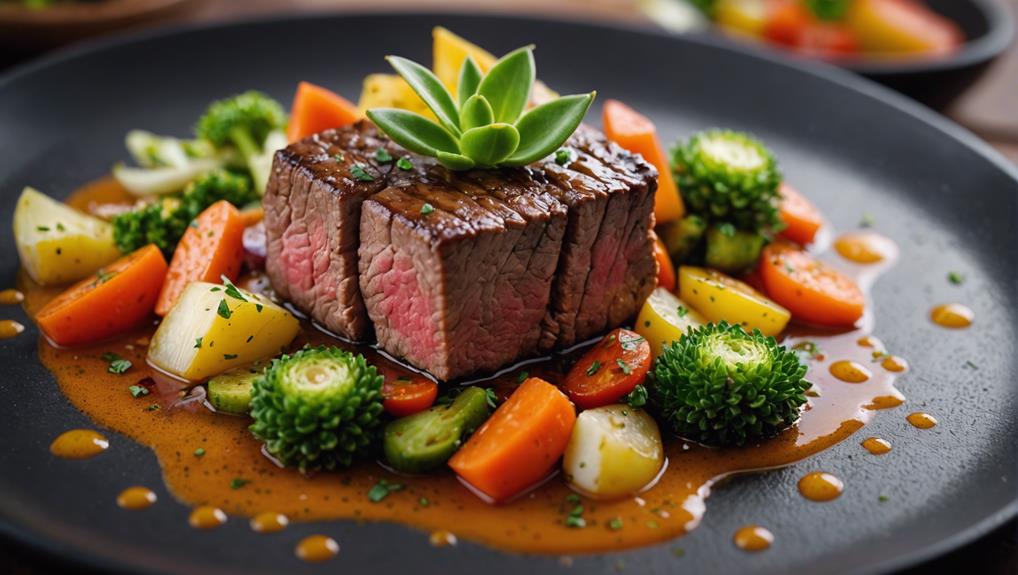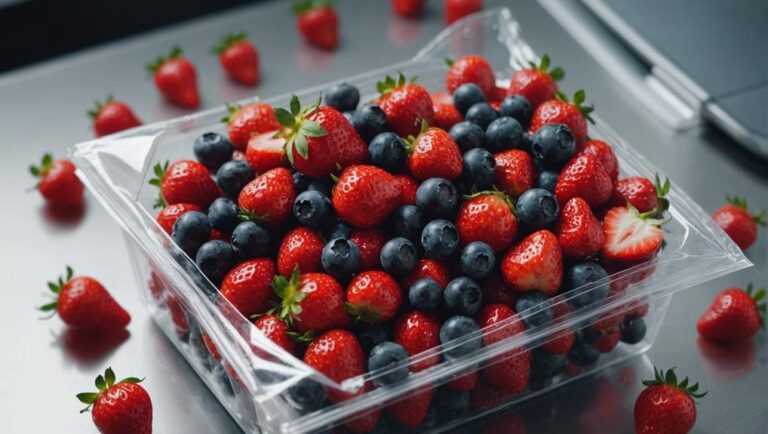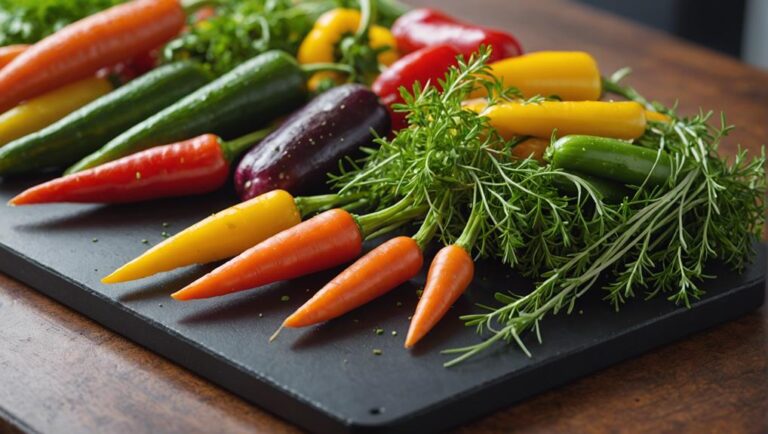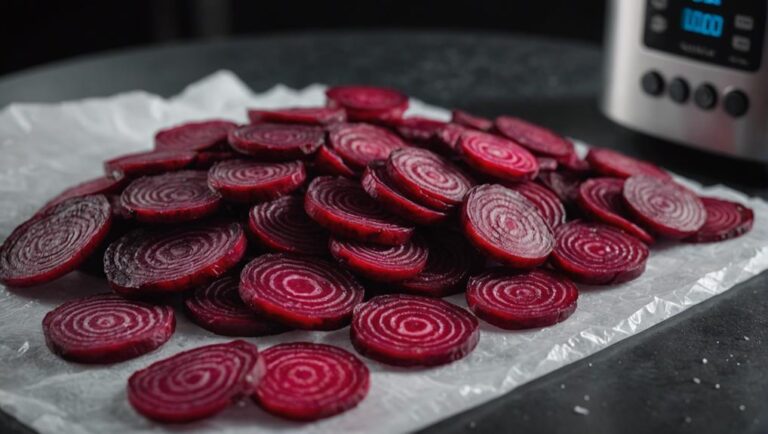Sous Vide Beef Vegetable Stew
Immerse in a symphony of flavors with Sous Vide Beef Vegetable Stew. Tender beef, vibrant veggies, and fragrant herbs blend in a slow-cooked masterpiece, warming you inside out.
What You Will Learn Here
- Sous vide method ensures precise cooking temperatures for tender beef and perfectly cooked vegetables.
- Vacuum sealing ingredients in bags retains flavors and nutrients for a delicious stew.
- Longer cooking times in sous vide enhance flavors and textures, resulting in a rich and hearty stew.
- Temperature control in sous vide cooking ensures consistent and evenly cooked beef and vegetables.
- Customizable seasonings and herbs infuse deeply into the ingredients, creating a flavorful beef vegetable stew.
Stewing Method Origins
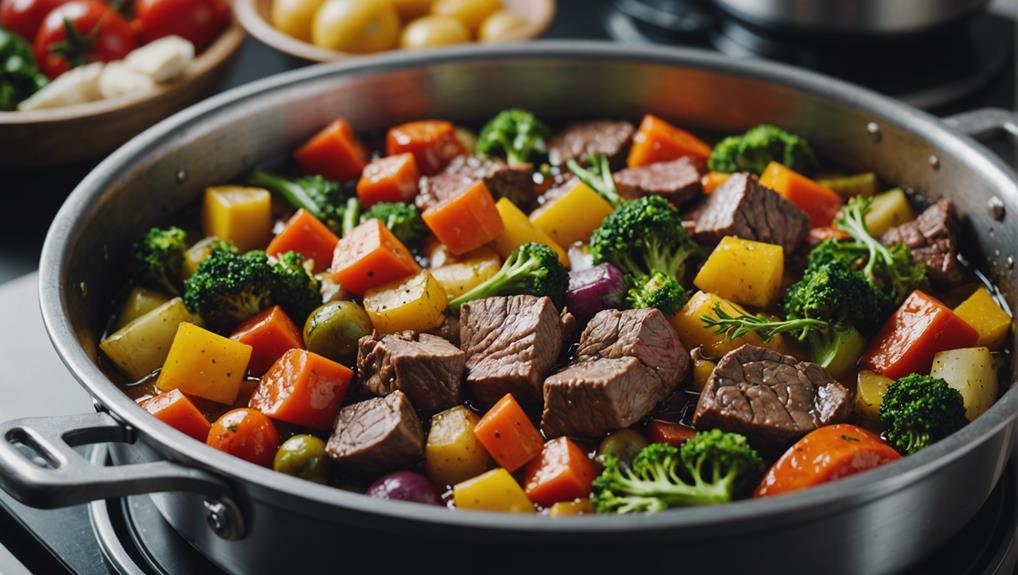
Imagine a time when stewing was a culinary art form handed down through generations, each family adding their own twist to the simmering pot.
The traditional techniques of slow-cooking tough cuts of meat with vegetables and herbs have roots that run deep in the history of cooking. Over time, this humble method of cooking has evolved into a diverse array of stews that tantalize the taste buds with their rich flavors and comforting warmth.
History of Stewing
Originating in ancient times, the method of stewing has been a culinary practice cherished for its ability to meld flavors and tenderize tough cuts of meat. Stewing involves simmering ingredients slowly in a liquid to create rich, flavorful dishes. This method allows for the infusion of various herbs, spices, and vegetables, resulting in a hearty, comforting meal that warms the soul. Across different cultures, stewing holds cultural significance, with each region adding its unique twist to traditional recipes. The process of stewing not only enhances the taste but also offers nutritional benefits by preserving the vitamins and minerals of ingredients. Below is a table showcasing the diverse ingredient variations and their nutritional benefits in stewing:
| Ingredient Variations | Nutritional Benefits |
|---|---|
| Meat (beef, lamb, chicken) | Good source of protein and iron |
| Root vegetables (carrots, potatoes) | High in fiber and vitamins |
| Legumes (beans, lentils) | Rich in plant-based protein and minerals |
| Aromatic herbs and spices | Antioxidant properties and added flavor |
| Broths (vegetable, bone) | Hydrating and adds depth to the stew |
Traditional Stew Techniques
The rich history of traditional stew techniques traces back to ancient culinary practices, where simmering ingredients slowly in a liquid transformed simple components into complex, flavorful dishes.
Traditional cooking methods involved using basic ingredients like meat, vegetables, and herbs, cooked over low heat for an extended period to meld flavors together. These techniques were passed down through generations, each family adding their unique touch to create signature stews.
Today, chefs continue to honor these time-honored traditions while adding a modern twist by experimenting with different seasonings, cuts of meat, and cooking vessels. The essence of traditional stewing lies in the slow process that allows flavors to develop and merge, resulting in hearty, comforting dishes that evoke a sense of nostalgia with every bite.
Evolution of Stew
Begin a culinary journey through time as you explore the origins of stewing methods, where the art of slowly cooking ingredients in liquid first began to take shape.
Stew evolution has a rich history, with traditional roots that date back centuries. Early civilizations used stewing as a way to tenderize tough cuts of meat by simmering them with herbs and vegetables over open flames.
Over time, culinary innovations led to the development of various techniques and flavor profiles. Modern adaptations have seen the traditional stewing method transformed by technologies like sous vide cooking, offering precise temperature control for perfect results.
Despite these advancements, the essence of stewing remains deeply connected to its humble beginnings, where patience and care in cooking create hearty and comforting meals.
Key Stew Components
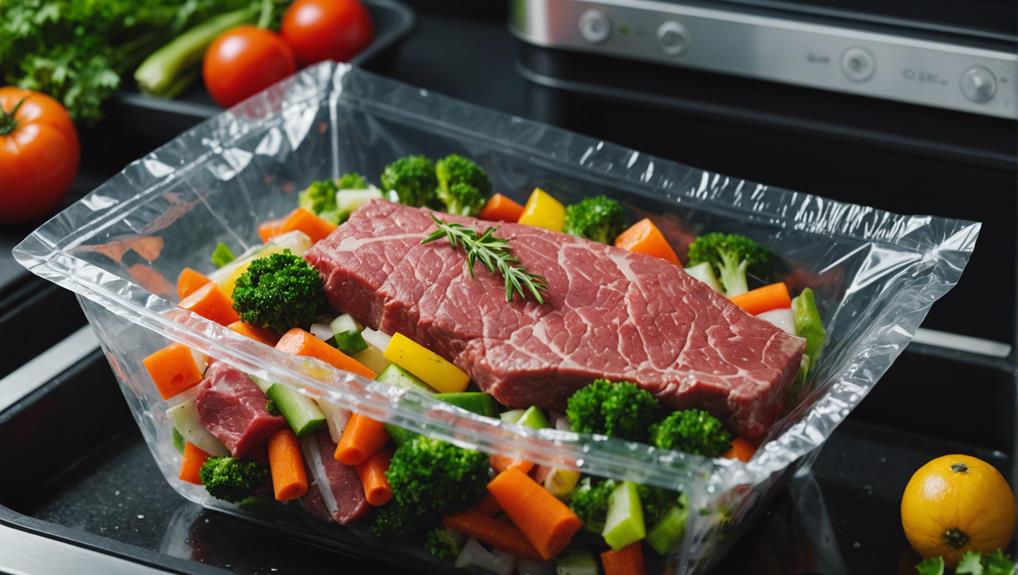
Enhance the flavor profile of your sous vide beef vegetable stew by carefully selecting the key components that will elevate each bite.
- Flavor Combinations: Experiment with a mix of savory herbs like rosemary and thyme, balanced with a hint of sweetness from caramelized onions or a splash of balsamic vinegar.
- Cooking Techniques: Utilize the sous vide method to guarantee each ingredient retains its unique taste and texture, allowing flavors to meld together perfectly over time.
- Ingredient Selection: Choose high-quality cuts of beef, fresh seasonal vegetables, and rich broth to create a robust base for your stew.
- Temperature Control: Maintain precise temperature settings during the sous vide cooking process to make certain that your beef is tender, vegetables are cooked to perfection, and flavors are harmoniously infused throughout the dish.
Savory Beef Stew Ideas
Imagine sinking your teeth into a rich and hearty beef stew, slowly cooked to perfection.
Picture a comforting beef shank stew, where the tender meat falls off the bone with each savory bite.
Or, perhaps, envision a wholesome beef and root vegetable stew, each ingredient melding together in a symphony of flavors.
Hearty Beef Stew Recipe
With a rich and robust blend of tender beef, vibrant vegetables, and savory broth, this hearty beef stew recipe promises a comforting and satisfying meal for any occasion. Imagine the aroma of slow-cooked beef filling your kitchen on a chilly winter day, offering warmth and comfort with every spoonful.
Here are some tips to elevate your stew game:
- Seer the Beef: For an extra depth of flavor, sear the beef before slow cooking.
- Add Wine: A splash of red wine can enhance the richness of the stew.
- Fresh Herbs: Don't underestimate the power of fresh herbs like thyme or rosemary.
- Root Vegetables: Potatoes, carrots, and parsnips add a hearty touch to your stew.
Embrace the freedom to customize and savor your perfect bowl of beef stew.
Beef Shank Stew Recipe
Infuse your kitchen with the tantalizing aroma of a savory beef shank stew simmering on the stove, beckoning you with its promise of rich flavors and tender meat. This hearty dish is perfect for a cozy night in or a gathering with friends.
Here are some tips to elevate your beef shank stew experience:
- Slow Cooker Adaptation: Consider making this stew in a slow cooker for added convenience and deeper flavors.
- Flavor Variations: Experiment with different herbs and spices to customize the taste to your liking.
- Cooking Time: Allow the stew to simmer slowly to make sure the meat becomes incredibly tender and flavorful.
- Meat Cuts: Opt for beef shank for its rich beefy flavor and melt-in-your-mouth texture.
Beef and Root Vegetable Stew
As you explore the world of savory beef stews, the Beef and Root Vegetable Stew captivates with its robust flavors and hearty ingredients. Picture a simmering pot filled with tender beef chunks, earthy root vegetables, and aromatic herbs, all melding together to create a comforting dish that warms you from the inside out. This slow-cooked masterpiece is a celebration of simplicity and depth, perfect for a cozy night in or a gathering with loved ones.
Slow cooking allows the flavors to intensify, creating a rich and luscious stew.
Comfort food at its finest, offering a nostalgic embrace with every spoonful.
The tender beef melts in your mouth, while the root vegetables add a delightful crunch.
Each bite is a symphony of textures and tastes, promising satisfaction with every mouthful.
Stew Thickness Adjustment
Adjusting the thickness of your stew can elevate its overall appeal and taste. Experimenting with different thickening agents like flour, cornstarch, or pureed vegetables can help you achieve the ideal consistency.
Thickening Agents Options
Enhance the texture of your stew by incorporating various thickening agents to achieve your desired consistency. Consider using a classic roux made from flour and butter for a rich and savory thickness.
Alternatively, cornstarch can be your go-to for a gluten-free option that yields a glossy finish.
Gelatin, extracted from animal collagen, offers a luxurious mouthfeel and can be an excellent choice for a more delicate stew.
Arrowroot, a plant-based thickener, is perfect for those looking to avoid gluten and achieve a clear, shiny appearance in their stew.
Experiment with these thickening agents to find the one that perfectly complements your sous vide beef vegetable stew.
Texture Enhancement Techniques
Consider refining the thickness of your stew by employing various texture enhancement techniques that will elevate the overall dining experience.
Through texture manipulation in sous vide cooking, you can achieve a sublime balance between tenderness and juiciness in each bite.
To enhance the stew's consistency, experiment with different cooking techniques like incorporating root vegetables or slow-cooking the ingredients to perfection.
These methods not only infuse the stew with layers of rich flavor but also contribute to a velvety mouthfeel that lingers on your palate.
Adjusting Liquid Ratio
To achieve peak stew thickness in your culinary creation, focus on masterfully balancing the liquid components to guarantee a harmonious blend of flavors and textures. The secret lies in adjusting the liquid consistency to achieve the perfect balance.
If your stew appears too thin, reduce the broth by simmering it uncovered. Conversely, if it's too thick, gently stir in small amounts of broth or water until reaching the desired consistency. Remember, the key is to maintain that delicate equilibrium between liquid and solids.
Additionally, consider the impact of cooking time and temperature adjustments on your stew's overall thickness. By carefully monitoring these factors, you can fine-tune your stew to achieve the ideal flavor balance and mouthfeel.
Final Thoughts
In reflecting on the delightful flavors and textures that meld together in this Sous Vide Beef Vegetable Stew, one can truly appreciate the artistry of this comforting dish. The slow cooking process of sous vide guarantees that each ingredient retains its essence, resulting in a harmonious blend of savory beef, tender vegetables, and aromatic herbs. As you savor each spoonful, you may find yourself transported to a cozy kitchen filled with the tantalizing scents of a hearty meal in the making.
The personal experience of preparing this stew allows for a deep connection with the ingredients and the culinary journey. The meticulous attention to detail in seasoning and cooking time pays off in the final product, offering a rich and satisfying dining experience. The tenderness of the beef, the vibrant colors of the vegetables, and the robust flavors of the broth all come together to create a symphony of taste that warms both body and soul. So, as you sit down to enjoy this Sous Vide Beef Vegetable Stew, take a moment to appreciate the effort and care that went into crafting this masterpiece for your palate.
Frequently Asked Questions
Can I Use a Slow Cooker Instead of Sous Vide for This Stew?
You can use a slow cooker as an alternative method for this stew. It will offer convenience and a traditional cooking approach. By opting for a slow cooker, you can still achieve a flavorful and tender result.
Are There Any Vegetarian Alternatives for This Beef Stew?
Looking for vegetarian substitutes and flavor options for your beef stew? Try meatless proteins like tempeh or seitan, and hearty alternatives such as lentils or chickpeas. Experiment with different seasonings to enhance taste.
Can I Freeze the Leftover Stew for Future Consumption?
Yes, you can freeze the leftover stew for future consumption. Proper storage is key. Allow it to cool completely, then transfer to airtight containers or freezer bags. Label with date for easy tracking. Enjoy your tasty meal later on!
What Are Some Recommended Side Dishes to Pair With This Stew?
Pair your stew with a robust red wine for a delightful contrast. Crunch into crusty baguette or fluffy garlic bread. Enjoy a fresh garden salad or opt for creamy mashed potatoes. The possibilities are endless!
Is It Possible to Make This Stew in Advance and Reheat It Later?
Yes, you can absolutely meal prep this stew for convenience. The flavors meld beautifully over time, enhancing the dish. When reheating, consider using sous vide techniques to maintain the tenderness of the beef and preserve all the delicious flavors.
Conclusion
As you peer into the sous vide pot, a rich aroma of tender beef and vibrant vegetables wafts up to greet you. The stew is a masterpiece of flavors melded together in perfect harmony, ready to warm your soul with each spoonful.
With just a few simple adjustments, you can customize the thickness of the stew to your liking, ensuring a satisfying meal every time.
Indulge in a bowl of comfort and savor the goodness of homemade beef vegetable stew.
